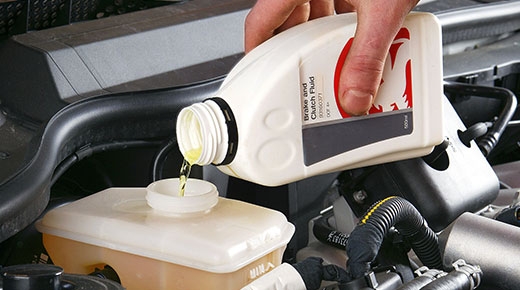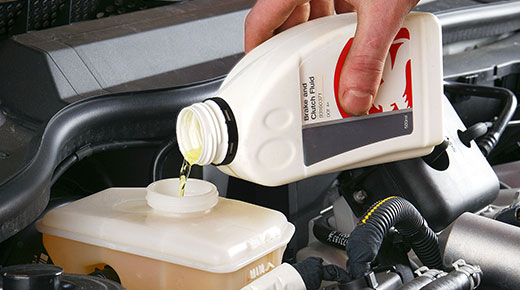Brake Fluid Change: A Comprehensive Guide

To ensure your vehicle’s safety and operational efficiency, regular maintenance is crucial. One aspect often overlooked but critical to your car’s braking system is the brake fluid. This article will delve deep into the world of brake fluid changes, exploring the importance of this procedure, signs that indicate it’s time for a change, the cost involved, and more.
1. The Importance of Brake Fluid
Brake fluid plays a vital role in your vehicle’s braking system. Acting as the lifeblood of your brakes, it’s responsible for transmitting the force of your foot on the brake pedal to the brake discs or shoes, allowing your vehicle to slow down or stop.
1.1. The Role of Brake Fluid
Like oil for your engine, brake fluid is critical for your vehicle’s safety. It operates under high temperatures and pressures, withstanding rigorous conditions while maintaining its properties.
1.2. Hydraulic Braking System
Modern vehicles predominantly use hydraulic brakes for slowing and stopping. Here, the brake fluid (also known as hydraulic fluid) comes into play. Over time, however, this fluid can become contaminated.
2. Contamination of Brake Fluid
Even though the hydraulic brake system is sealed, the brake fluid can become dirty and contaminated over several years of normal use.
2.1. Causes of Contamination
There are several causes of brake fluid contamination. The additives in the brake fluid may wear out over time, or moisture can find its way into the hydraulic brake system and start to affect the brake fluid chemistry.
2.2. Effects of Contaminated Brake Fluid
Contaminated brake fluid can dramatically impact your brakes’ performance. You may notice a spongy feeling when you step on the pedal, or your vehicle may not stop as quickly when making a hard stop.
3. Signs You Need a Brake Fluid Change
Recognizing the signs that your vehicle needs a brake fluid change is crucial to maintaining its optimal performance and safety.
3.1. Soft, Spongy, or Bouncy Brake Pedal
A soft, spongy or bouncy brake pedal is a common sign that a brake fluid change is due. If you need to press the brake pedal all the way down before your vehicle slows or stops, it’s time for a brake fluid check.
3.2. ABS Dashboard Light
The ABS dashboard light indicates an issue with your anti-lock braking system. If this light comes on, it could be a sign that your brake fluid is low and needs replacing.
3.3. Ineffective Braking Performance
Any delays or difficulties while slowing or stopping could indicate a need for a brake fluid change. Other potential issues could be warped rotors, worn brake pads, or a problem with another brake system component.
3.4. Strange Noises or Smells when Braking
Unusual sounds or burning smells while braking could be due to low brake fluid or another brake system issue. If you notice these signs, it’s best to get your vehicle checked by a professional.
4. Brake Fluid Change Frequency
Knowing how often to change your brake fluid is also essential. Most manufacturers recommend replacing your brake fluid every two to three years or every 45,000 miles, whichever comes first.
4.1. Manufacturer’s Recommendations
Each vehicle manufacturer may have different recommendations for brake fluid change intervals. Therefore, it’s best to refer to your vehicle’s owner manual for precise information.
4.2. Visual Check
You can also perform a visual check of the brake fluid yourself. If the fluid looks dark or murky, it’s time for a brake fluid change.
5. Types of Brake Fluid
There are several types of brake fluid available, including D.O.T. 3, D.O.T. 4, and D.O.T. 5. Each type has its pros and cons, and the type of brake fluid your vehicle needs will depend on its make and model.
5.1. D.O.T. 3 and D.O.T. 4 Fluid
Many vehicles call for either D.O.T. 3 or D.O.T. 4 fluid. These brake fluids have been around for a while and are trusted by several vehicle manufacturers.
5.2. D.O.T. 5 Fluid
D.O.T. 5 fluid is a newer variant and has several advantages. It doesn’t eat paint or absorb moisture, making it a great improvement over its predecessors. However, because it doesn’t absorb water, any water that enters your brake system can form pools that can corrode your brakes.
6. Changing Brake Fluid: DIY Approach
Changing brake fluid yourself is possible, but it requires some mechanical know-how and the right tools.
6.1. Tools and Materials
To change your brake fluid, you’ll need a baster for removing the old fluid and some lint-free cloth for wiping out the reservoir. You’ll also need fresh brake fluid and possibly a brake fluid test kit.
6.2. The Process
The process involves removing the dirty fluid from the master cylinder reservoir, cleaning it, and refilling it with fresh brake fluid.
7. Professional Brake Fluid Change Services
Service facilities now use brake flushing machines to change brake fluid.
7.1. Brake Fluid Flushing Machines
These machines flush and replace the brake fluid in your brake system, ensuring a thorough and efficient process.
7.2. Professional Recommendations
If there’s no recommendation in your vehicle’s owner manual about how often to change brake fluid, you can consult a professional technician for guidance.
8. Brake Fluid Change Cost
The cost of a brake fluid change can vary depending on your vehicle’s make and model and the service provider. However, it’s generally affordable and much less expensive than the cost of replacing brake system components damaged by contaminated brake fluid.
9. Routine Maintenance for Brake Fluid Changes
Routine maintenance is key to keeping your vehicle running smoothly. On average, a brake fluid change is recommended every 2 years or 30,000 miles, depending on your driving patterns. In case, you are living in Sharjah and looking for a trusted car garage to ac repair sharjah, we would like to suggest Service My Car, the best and trusted car ac repair in Sharjah.
10. Conclusion
A brake fluid change is a crucial part of vehicle maintenance. Whether you choose to do it yourself or opt for professional service, regular brake fluid changes will ensure your vehicle’s safety and optimal performance. So, don’t wait for signs of trouble. Keep your brakes in top shape with timely brake fluid changes.
- Industry
- Art
- Causes
- Crafts
- Dance
- Drinks
- Film
- Fitness
- Food
- Games
- Gardening
- Health
- Home
- Literature
- Music
- Networking
- Other
- Party
- Religion
- Shopping
- Sports
- Theater
- Wellness
- News












